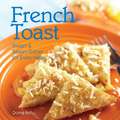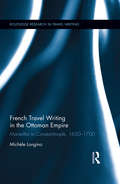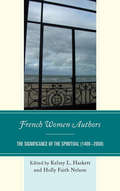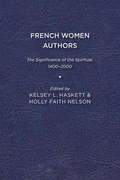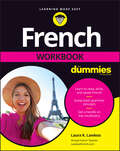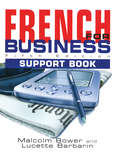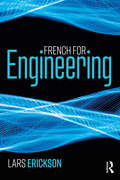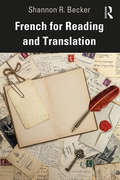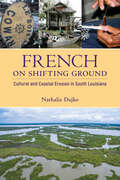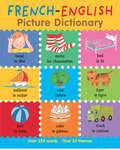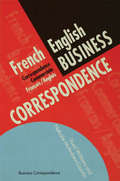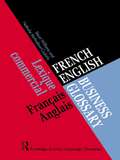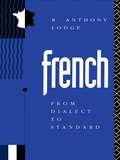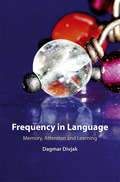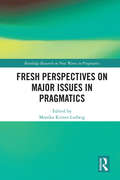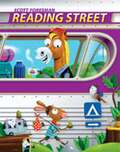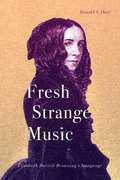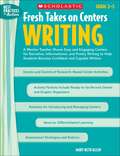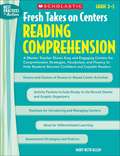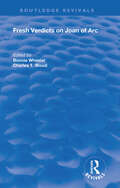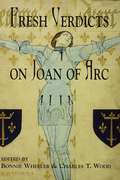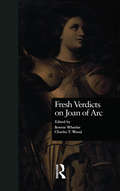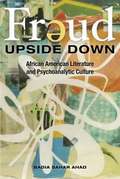- Table View
- List View
French Toast: Sweet and Savory Treats for Every Meal
by Donna KellyPush aside the syrup and rejuvenate a classic comfort food with these 70 easy-to-use, sweet and savoury recipes for lunch, dinner and dessert as well as breakfast. With beautiful colour photography, these tasty dishes range from classics like French Toast Blueberry Cobbler and French Toast Bread Pudding to creative casseroles and entrees such as Crab Strata Supreme and Tomato Basil Monte Cristos.
French Tragic Drama in the Sixteenth and Seventeenth Centuries: A Textbook On The Principles And Details Of Modern Construction First Stage (or Elementary Course) (Geoffrey Brereton on French Tragic and Comic Drama)
by Geoffrey BreretonOriginally published in 1973, the history of French tragedy and tragicomedy from their origins in the sixteenth century to the last years of Louis XIV’s reign is here surveyed in a single volume. Beginning with a brief account of the development of drama from the Middle Ages to the Renaissance, Dr Brereton examines the plays as types of drama, the circumstances in which they were produced and their reception by contemporaries. The traditionally great figures of Corneille and Racine are treated at some length, but their work is seen in perspective against the plays of their predecessors and of their own time. Garnier and Montchrestien are discussed, among others, as notable writers of Renaissance humanist tragedy. Sections are devoted to secondary but still important dramatists such as Mairet, Rotrou, Du Ryer, Tristan L’Hermite, Thomas Corneille and Quinault. A long chapter on Alexandre Hardy reviews the work of this neglected author and stresses his interest as a transitional link between the two centuries and as a vigorous pioneer of a type of drama which flourished for several decades after him concurrently with French ‘classical’ tragedy. The main currents of critical theory, social attitudes and stage history are described in their relation to the development of the drama. Well over a hundred plays are discussed or summarized; and the author has constantly referred back to the original material and has avoided an over-simplification of a vast subject which contains more exceptions and anomalies than has generally been recognized in the past. Chronological tables of the works of major dramatists, summaries of numerous plays and a bibliography containing modern editions of plays are included.
French Travel Writing in the Ottoman Empire: Marseilles to Constantinople, 1650-1700 (Routledge Research in Travel Writing)
by Michele LonginoExamining the history of the French experience of the Ottoman world and Turkey, this comparative study visits the accounts of early modern travelers for the insights they bring to the field of travel writing. The journals of contemporaries Jean-Baptiste Tavernier, Jean Thévenot, Laurent D’Arvieux, Guillaume-Joseph Grelot, Jean Chardin, and Antoine Galland reveal a rich corpus of political, social, and cultural elements relating to the Ottoman Empire at the time, enabling an appreciation of the diverse shapes that travel narratives can take at a distinct historical juncture. Longino examines how these writers construct themselves as authors, characters, and individuals in keeping with the central human project of individuation in the early modern era, also marking the differences that define each of these travelers – the shopper, the envoy, the voyeur, the arriviste, the ethnographer, the merchant. She shows how these narratives complicate and alter political and cultural paradigms in the fields of Mediterranean studies, 17th-century French studies, and cultural studies, arguing for their importance in the canon of early modern narrative forms, and specifically travel writing. The first study to examine these travel journals and writers together, this book will be of interest to a range of scholars covering travel writing, French literature, and history.
French Women Authors: The Significance of the Spiritual, 1400–2000
by Holly Faith Nelson Katharine Bubel Sinda Vanderpool Deborah Sullivan-Trainor Hadley Wood Kelsey L. Haskett Anne M. François Susan UdryFrench Women Authors examines the importance afforded the spiritual in the lives and works of French women authors over the centuries, thereby highlighting both the significance of spiritually informed writings in French literature in general, as well as the specific contribution made by women writers. Eleven different authors have been selected for this collection, representing major literary periods from the medieval to the (post)modern. Each author is examined in the light of a Christian worldview, creating an approach which both validates and interrogates the spiritual dimension of the works under consideration. At the same time, the book as a whole presents a broad perspective on French women writers, showing how they reflect or stand in opposition to their times. The chronological order of the chapters reveals an evolution in the modes of spirituality expressed by these authors and in the role of spiritual belief or religion in French society over time. From the overwhelmingly Christian culture of the Middle Ages and pre-Enlightenment France to the wide diversity prevalent in (post)modern times, including the rise of Islam within French borders, a radical shift has permeated French society, a shift that is reflected in the writers chosen for this book. Moreover, the sensitivity of women writers to the individual side of spiritual life, in contrast with the practices of organized religion, also emerges as a major trend in this book, with women often being seen as a voice for social and religious change, or for a more meaningful, personal faith. Lastly, despite a blatant rejection of God and religion, spiritual threads still run through the works of one of France’s most celebrated contemporary writers (Marguerite Duras), whose cry for an absolute in the midst of a spiritual vacuum only reiterates the quest for transcendence or for some form of spiritual expression, as voiced in the works of her female predecessors and contemporaries in France, and as demonstrated in this book. Published by University of Delaware Press. Distributed worldwide by Rutgers University Press.
French Women Authors: The Significance of the Spiritual, 1400–2000
by Holly Faith Nelson Katharine Bubel Sinda Vanderpool Deborah Sullivan-Trainor Hadley Wood Kelsey L. Haskett Anne M. François Susan UdryFrench Women Authors examines the importance afforded the spiritual in the lives and works of French women authors over the centuries, thereby highlighting both the significance of spiritually informed writings in French literature in general, as well as the specific contribution made by women writers. Eleven different authors have been selected for this collection, representing major literary periods from the medieval to the (post)modern. Each author is examined in the light of a Christian worldview, creating an approach which both validates and interrogates the spiritual dimension of the works under consideration. At the same time, the book as a whole presents a broad perspective on French women writers, showing how they reflect or stand in opposition to their times. The chronological order of the chapters reveals an evolution in the modes of spirituality expressed by these authors and in the role of spiritual belief or religion in French society over time. From the overwhelmingly Christian culture of the Middle Ages and pre-Enlightenment France to the wide diversity prevalent in (post)modern times, including the rise of Islam within French borders, a radical shift has permeated French society, a shift that is reflected in the writers chosen for this book. Moreover, the sensitivity of women writers to the individual side of spiritual life, in contrast with the practices of organized religion, also emerges as a major trend in this book, with women often being seen as a voice for social and religious change, or for a more meaningful, personal faith. Lastly, despite a blatant rejection of God and religion, spiritual threads still run through the works of one of France’s most celebrated contemporary writers (Marguerite Duras), whose cry for an absolute in the midst of a spiritual vacuum only reiterates the quest for transcendence or for some form of spiritual expression, as voiced in the works of her female predecessors and contemporaries in France, and as demonstrated in this book. Published by University of Delaware Press. Distributed worldwide by Rutgers University Press.
French Workbook For Dummies
by Laura K. LawlessWrite, read, work, and play—en Français French Workbook For Dummies is the perfect starting place for beginners who want to learn French. Packed with foundational grammar and integrated vocab, this hands-on book will set you on your way to picking up a new language. You&’ll find valuable practice lessons and exercises throughout that help you learn key vocabulary and phrases, writing in French, and understanding the fifth most commonly spoken language worldwide. Start with the very basics of the French language and work your way through important grammar and vocabulary Follow lessons at your own pace and complete practice exercises to hone your skill Learn using the Dummies method—based on evidence about how people learn best Gain the confidence to speak French in the workplace and while you travelFor anyone learning French for use at home, at the office, or on the go, French Workbook For Dummies is a vital asset.
French for Business: Students Book, 5th Edition (French For Business Ser.)
by Lucette Barbarin Malcolm BowerFirst published in 2002. Routledge is an imprint of Taylor & Francis, an informa company.
French for Engineering
by Lars EricksonFrench for Engineering prepares students to study and intern in France as engineers. Aimed at students at the CEFR B1 or ACTFL Intermediate-High level, the textbook uses a step-by-step progression of language-learning tasks and activities to develop students’ skills at the CEFR C1 or ACTFL Advanced-High level. Authentic documents present students with tasks they will encounter as engineering students or interns in France. Online resources include a teacher handbook and a workbook with vocabulary-building activities, grammar-mastery exercises, and listening and reading comprehension activities, followed by questions requiring critical thinking. It is organized in parallel with the textbook based on the flipped-classroom concept.
French for Reading and Translation
by Shannon R. BeckerFrench for Reading and Translation is a comprehensive introduction to French grammar and vocabulary for those who want to learn to read and understand French, either to conduct academic research or to experience French literature in its original form. Rather than explaining every grammatical concept in tedious detail, the book gives easy-to-follow explanations followed by abundant examples and opportunities to see the language in use. It encourages readers to learn vocabulary by showing them how to break it down and how to recognize related words. It gives learners the opportunity to use various reading strategies as they apply this newfound knowledge to the French passages provided. An engaging guide that will help readers decode the intricacies of the French language, this is an ideal resource for graduate students and researchers consulting French sources.
French on Shifting Ground: Cultural and Coastal Erosion in South Louisiana (America's Third Coast Series)
by Nathalie DajkoIn French on Shifting Ground: Cultural and Coastal Erosion in South Louisiana, Nathalie Dajko introduces readers to the lower Lafourche Basin, Louisiana, where the land, a language, and a way of life are at risk due to climate change, environmental disaster, and coastal erosion. Louisiana French is endangered all around the state, but in the lower Lafourche Basin the shift to English is accompanied by the equally rapid disappearance of the land on which its speakers live. French on Shifting Ground allows both scholars and the general public to get an overview of how rich and diverse the French language in Louisiana is, and serves as a key reminder that Louisiana serves as a prime repository for Native and heritage languages, ranking among the strongest preservation regions in the southern and eastern US. Nathalie Dajko outlines the development of French in the region, highlighting the features that make it unique in the world and including the first published comparison of the way it is spoken by the local American Indian and Cajun populations. She then weaves together evidence from multiple lines of linguistic research, years of extensive participant observation, and personal narratives from the residents themselves to illustrate the ways in which language—in this case French—is as fundamental to the creation of place as is the physical landscape. It is a story at once scholarly and personal: the loss of the land and the concomitant loss of the language have implications for the academic community as well as for the people whose cultures—and identities—are literally at stake.
French-English Picture Dictionary (First Bilingual Picture Dictionaries)
by Louise Millar Susan Martineau Catherine BruzzoneAre there kids in your life who want to learn French? This is the perfect dictionary! Included are pages filled with bright and colorful pictures and bilingual labels to help teach French words to English speaking children.Parents, teachers, and gift givers will find:350 illustrations of familiar objectsPictures labeled with the English word followed by its French equivalentPhonetic spellings of French wordsWords grouped by themesThis dictionary is a fun way for young English-speaking children to build a basic vocabulary in French. It's never too soon to start teaching boys and girls a second language!
French/English Business Correspondence: Correspondance Commerciale Francais/Anglais (Languages For Business Ser.)
by Stuart Williams Nathalie McAndrew CazorlaFrench/English Business Correspondence is a handy reference and learning text for all who use written French for Business. Eighty written communications are simply presented covering memos, letters, faxes and resumes. The situations covered include: * arranging meetings * acknowledging orders * enquiring about products * applying for jobs. With full English translations, this book is suitable for both students and professionals and can be used for either reference or class use.
French/English Business Glossary (Business Language Glossaries Ser.)
by Stuart Williams Nathalie McAndrew CazorlaThis is the essential reference companion for all who use French for business communication. Containing over 5000 words, this handy two-way A-Z glossary covers the most commonly used terms in business. It will help you to communicate with confidence in a wide variety of business situations, and is of equal value to the relative beginner or the fluent speaker. Written by an experienced native and non-native speaker team working in business language education, this unique glossary is an indispensable reference guide for all students and professionals studying or working in business where French is used.
French: From Dialect to Standard
by R. Anthony LodgeWritten as a text, this book looks at the external history of French from its Latin origins to the present day through some of the analytical frameworks developed by contemporary sociolinguistics. French is one of the most highly standardized of the world's languages and the author invites us to see the language as heterogenous, rather than a monolithic entity, using the model proposed by E. Haugen as a useful comparative grid to plot the development of standardization. After an introductory section which examines the dialectalization of Latin in Gaul, the four central chapters of the book are constructed around the basic processes invoved in standardization as identified by Haugen: the selection of norms, the elaboration of function, codification and acceptance. The concluding chapter deals with language variability and the wide gulf that has now developed between French used for formal purposes and that used in everyday speech, with particular reference to Occitan speaking regions. Emphasizing the ordinary speakers of the language, rather than the statesmen or great authors as agents of change, the book combines a traditional history of the language' approach with a sociolinguistic framework to provide a broad and comparative overview of the problem of language standardization.
Frequency in Language: Memory, Attention and Learning (Trends In Linguistics. Studies And Monographs [tilsm] Ser. #244.2)
by Dagmar DivjakCognitive linguists are bound by the cognitive commitment, which is the commitment to providing a characterization of the general principles governing all aspects of human language, in a way that is informed by, and accords with, what is known about the brain and mind from other disciplines. But what do we know about aspects of cognition that are relevant for theories of language? Which insights can help us build cognitive reality into our descriptive practice and move linguistic theorizing forward? This unique study integrates research findings from across the cognitive sciences to generate insights that challenge the way in which frequency has been interpreted in usage-based linguistics. It answers the fundamental questions of why frequency of experience has the effect it has on language development, structure and representation, and what role psychological and neurological explorations of core cognitive processes can play in developing a cognitively more accurate theoretical account of language.
Fresh Perspectives on Major Issues in Pragmatics (Routledge Research on New Waves in Pragmatics)
by Monika Kirner-LudwigThis book showcases new and innovative developments and approaches in pragmatics, spotlighting perspectives from an international range of emerging scholars undertaking cutting-edge research pushing the field in new directions. The volume begins by taking stock of the most up-to-date developments in pragmatics research, as embodied by the work of a newer generation of pragmaticists. Chapters are organized around key areas of development within pragmatics, including intercultural and cross-cultural pragmatics, cognitive pragmatics, and new perspectives on referencing, implicating, and inferring, shedding further light on the ways in which pragmatics increasingly interfaces with other linguistic disciplines and on innovative methodologies. The book also places the focus on pragmatics approaches in languages other than than English, further expanding the borders of research. This book will be of particular interest to scholars in pragmatics interested in staying on top of the latest developments and future directions for the field.
Fresh Reads for Fluency and Comprehension: Grade 3 (Reading Street)
by Scott ForesmanThe third installment of the Reading Street series, Grade 3, delivers structured content designed for children who have a firm foundation in English and Language Arts and are ready to continue on the path to lifelong reading. This curriculum for homeschooling brings together classic reading selections, fun activities and parent/teacher guides to help you develop lessons that boost your student's English and Language Arts learning. As with all levels of Reading Street, Grade 3 was created using educational research to ensure your child is guided through his or her work by age-appropriate and cutting-edge content. Each week, your child will work through a series of reading and writing activities that center around a Big Idea. This structure supports your child's critical thinking skills and ensures he or she builds knowledge suitable for a child in third Grade. <p><p>Reading Street: Grade 3 will give you the tools you need to achieve these learning goals during your homeschool program. Grade 3 comes in a two-volume set that's packed with engaging reading materials and helpful teacher tools. You'll be able to keep tabs on your child's progress through this level by using the assessment materials. If your child needs to revisit a certain lesson, you can ensure he or she does so and fully comprehends the subject.
Fresh Strange Music
by Donald S. HairElizabeth Barrett Browning evokes several figures as muses for her poetry, and one recurring type is the music master. While her writing has always been recognized as highly experimental, the influence and use of music in her work have not been fully examined. Fresh Strange Music defines the exact nature of Browning's experiments and innovations in rhythm, which she called the "animal life" of poetry, and in sound repetition, which she labelled her "rhymatology." Donald Hair approaches Elizabeth Barrett Browning's art with a focus on the power that shapes it - the technical music of her poetry and the recurring beat at the beginning of units of equal time that requires a different system of scansion than conventional metres and syllable counting. Music for Barrett Browning, Hair explains, has momentous implications. In her early poetry, it is the promoter of kindly and loving relations in families and in society. Later in her career, she makes it the basis of nation-building, in her support for the unification of Italy and, more problematically, in her championing of French emperor Napoleon III. Fresh Strange Music traces the development of Barrett Browning's poetics through all her works - from the early An Essay on Mind to Last Poems - showcasing her as a major poet, independently minded, and highly innovative in her rhythms and rhymes.
Fresh Strange Music: Elizabeth Barrett Browning's Language
by Donald S. HairElizabeth Barrett Browning evokes several figures as muses for her poetry, and one recurring type is the music master. While her writing has always been recognized as highly experimental, the influence and use of music in her work have not been fully examined. Fresh Strange Music defines the exact nature of Browning's experiments and innovations in rhythm, which she called the "animal life" of poetry, and in sound repetition, which she labelled her "rhymatology." Donald Hair approaches Elizabeth Barrett Browning's art with a focus on the power that shapes it - the technical music of her poetry and the recurring beat at the beginning of units of equal time that requires a different system of scansion than conventional metres and syllable counting. Music for Barrett Browning, Hair explains, has momentous implications. In her early poetry, it is the promoter of kindly and loving relations in families and in society. Later in her career, she makes it the basis of nation-building, in her support for the unification of Italy and, more problematically, in her championing of French emperor Napoleon III. Fresh Strange Music traces the development of Barrett Browning's poetics through all her works - from the early An Essay on Mind to Last Poems - showcasing her as a major poet, independently minded, and highly innovative in her rhythms and rhymes.
Fresh Takes on Centers: A Mentor Teacher Shares Easy and Engaging Centers for Narrative, Informational, and Poetry Writing to Help Students Become Confident and Capable Writers
by Mary AllenIn this comprehensive resource, veteran teacher, reading specialist, and staff developer Mary Beth Allen shares her time-tested organizational tips and tools for easy-to-implement, research-based writing centers. Reproducible activity packets come complete with student directions, templates, record sheets, and graphic organizers to facilitate independent learning. Mary Beth also offers ideas for differentiation, assessment suggestions and rubrics, record-keeping forms for tracking student progress, and much more. For use with Grades 3.5.
Fresh Takes on Centers: Reading Comprehension
by Mary Beth AllenIn this comprehensive resource, veteran teacher, reading specialist, and staff developer Mary Beth Allen shares her time-tested organizational tips and tools for easy-to-implement, research-based reading centers. Reproducible activity packets come complete with student directions, templates, record sheets, and graphic organizers to facilitate independent learning. Mary Beth also offers ideas for differentiation, assessment suggestions and rubrics, record-keeping forms for tracking student progress, and much more. For use with Grades 3-5.
Fresh Verdicts on Joan of Arc
by Bonnie Wheeler and Charles T. WoodFirst published in 1996. This volume of original essays employs the latest tools of historical analysis, literary criticism, and feminist inquiry to reval why Joan of Arc was such an important figure.
Fresh Verdicts on Joan of Arc (New Middle Ages #Vol. 1976)
by Bonnie Wheeler Charles T. WoodThis volume of original essays employs the latest tools of historical analysis, literary criticism, and feminist inquiry to reval why Joan of Arc was such an important figure.
Fresh Verdicts on Joan of Arc (New Middle Ages #Vol. 1976)
by Bonnie Wheeler Charles T. WoodFirst published in 1996. Routledge is an imprint of Taylor & Francis, an informa company.
Freud Upside Down
by Badia Sahar AhadThis thought-provoking cultural history explores how psychoanalytic theories shaped the works of important African American literary figures. Badia Sahar Ahad details how Nella Larsen, Richard Wright, Jean Toomer, Ralph Ellison, Adrienne Kennedy, and Danzy Senna employed psychoanalytic terms and conceptual models to challenge notions of race and racism in twentieth-century America. Freud Upside Down explores the relationship between these authors and intellectuals and the psychoanalytic movement emerging in the United States over the course of the twentieth century. Examining how psychoanalysis has functioned as a cultural phenomenon within African American literary intellectual communities since the 1920s, Ahad lays out the historiography of the intersections between African American literature and psychoanalysis and considers the creative approaches of African American writers to psychological thought in their work and their personal lives.
